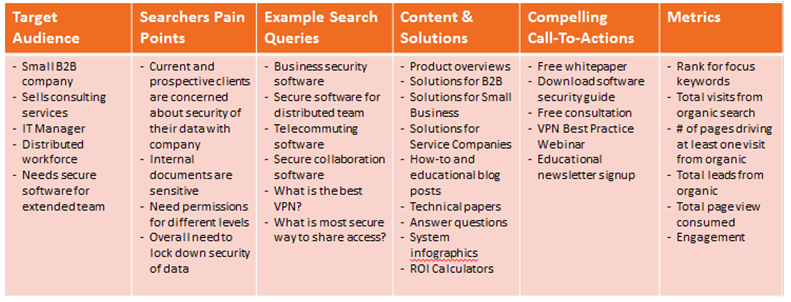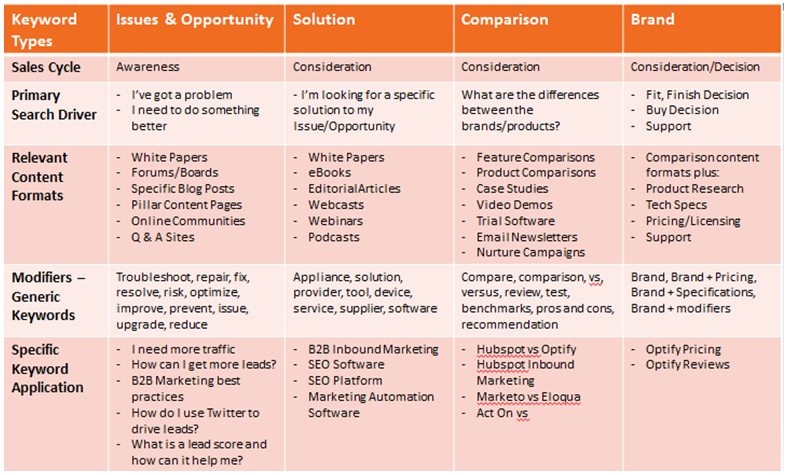Better SEO Through Content Marketing

By Scott Fasser, Director of Customer Experience at Optify
Search Engine Optimization (SEO) and Content Marketing are two critical components of inbound marketing and have moved beyond siloed visibility tactics to an integrated strategy to drive high quality visitors and prospects to your website. These are critical components of a company's core messaging and dramatically affect how these messages are portrayed to bring the right visitors with the highest chance of becoming customers.
Your content marketing strategy will provide the biggest boost to your organic search visibility if you follow these four rules:
1) Know your key personas - intimately
2) Write to all stages of the buy cycle
3) Talk outside-in vs. inside-out
4) Write in the same direction
Know Your Key Personas - Intimately
We all know how important it is to know your customers, core audience and key personas. This insight influences product development, customer service, sales close rates and marketing. This applies directly to the content you create - especially for B2B companies - who usually have a limited content creation budget (time or dollars). The clearer the picture of your personas are, the more targeted your content creation will be resulting in higher quality visitors that are closer to your ideal prospect.
In order to make the persona work actionable for your keyword and content strategy, we answer the following questions for each persona:
- What are the main types of business problems the persona typically needs to solve?
- How does your product or service provide solutions to these problems?
- What are some specific tasks the searcher wants to accomplish?
- What are some sample search queries the persona might use?
- What can the site provide that will cause the searcher to accomplish this task?
- What is your business goal for the visitor? Lead gen? Newsletter sign-up? Demo?
- How will the searcher be motivated to complete this business goal? i.e., what's the offer or incentive? What is the call-to-action?
With this intimate knowledge of your audience in hand, you can craft more relevant keyword and content topics. The following is an example of the matrix we build for each key persona to help develop keyword and content strategies:

Write to All Stages of the Buy Cycle
A lot of B2B websites build content around their brand and products/services. Obviously, this is super important when people discover your brand to move prospects towards a lead and sale. However, this focus leaves out the much larger potential audience (your Key Personas) of those who don't know your brand and are looking to solve a problem, looking for companies that are in a category or are comparing other brands for consideration.
Here are the four main stages of the buy cycle to build content for and the appropriate types of format for each:

Today's B2B websites must get out of the role of simply a glorified brochure for the company's products and into the role as the authority in your industry. This is the best way to achieve organic visibility success. Writing to all stages of the buy cycle helps you achieve this.
Talk Outside-In vs. Inside-Out
How you talk about yourself and market yourself, dramatically impacts how well you are found via organic channels - especially SEO. If your website is driven by a brand perspective that creates new phrases to describe what you do that is unique to your communication, you are not creating a true differentiation in your product, but new words to describe something that prospects don't understand. If you have a large marketing budget to create searches for these new words, great. But most companies - especially smaller companies - don't have this luxury.
We see examples of this tension between what the brand marketers tend to want - unique concepts to describe their positioning - versus what the direct marketers tend to want - clear language the speaks to the category and specific solutions that are high traffic search terms - at all types and sizes of companies. Here are two examples:
A major marketing automation company has positioned themselves as a provider of "Revenue Performance Management" software. This term could mean many different things to different functional perspectives, but the core term for this category of service is marketing automation. "Revenue performance management" has about 590 searches in Google in North America per month while "marketing automation" has 14,800. This tells us that marketing automation is a better known term and more people are looking for this type of solution than "revenue performance management."
Another recent example is an agency that describes their custom content management system as a "publishing strategy" capability. They rank very well for the phrase "publishing strategy" but have had zero visits from the phrase because very few people are searching for it whereas content marketing is a very hot topic right now, has a much higher number of searches and fits the agencies core capabilities very well.
The lesson here it to review your current and future messaging from the point of view of a persona that does not know about your brand, focus on true differentiation/value proposition and create content that they will understand without needing an explanation. Finding that balance between pushing new concepts and terms vs. serving the market where it exists today is an important input into your content marketing planning.
Write in the Same Direction
Content creation and SEO is no longer limited to the marketing department and copywriters. Blogs, social media, press releases, video, podcasting, etc. has created a plethora of ways to easily publish content to your company and other industry related sites. Profiles on Facebook, LinkedIn, Twitter, SlideShare, Pinterest, Google + mean that there are MORE places to fill with content. All of this communication impacts your brand and visibility - positively or negatively.
One of the most important things you can do to amplify your content strategy is to get as many people in your organization to understand how their work can impact the SEO program and what they should to contribute. By giving them the education and the game plan for what key messaging and keywords are reinforces the central promise of your business.
Here is the approach we have found successful:
- Get executive sponsorship to back your SEO/Content initiative. Without a strong top-level executive supporting this process, you will run into major barriers. Assign someone in marketing as the leader of the effort.
- Assemble a tiger team of people from different parts of the organization including: Marketing, Editors, Web Development, Social, PR, Sales and Executive. Include them in the persona development, keyword recommendations and content strategy development process.
- Build a list of blog, article, whitepaper and webinar topics that align with the keyword strategy. Create an editorial calendar that aligns the proposed topics with keywords. The team leader should manage this list.
- Open up the opportunity to become an official company blogger to the greater company. There are many people in your organization who are currently writing or would like to write and boost their own profile. Each one of these individuals also has their own social network that they can publish to when they write.
- Baseline metrics around organic visits, engagement, leads/business goals by source, size of social networks, track individual story syndication, etc. This topic alone is an entire whitepaper!
- Meet with the greater blog team monthly, review results and celebrate those who have seen the most engagement and syndication (we give out Amazon gift certificates). - Rinse, lather and repeat. Organic visibility through content and SEO must become part of your company DNA to be successful - it is NOT a one and done project.
It's a Marathon, Not a Sprint
Changing the core messaging and approach to content creation is not easy. The larger the organization, the more challenging it is to get approval and buy-in to build a sustainable content marketing program that will significantly move the needle in SEO. However, once the process is defined and rolling and you start to see the results, this type of marketing will be the foundation for sustaining and growing your business for years to come.
About the Author: Scott Fasser, VP of Customer Experience at Optify has over 20 years of experience in launching products in diverse industries such as online marketing, digital media, e-commerce, and electronic entertainment at companies such as Optify, RealNetworks, Domain Strategies, Amazon, Avenue A, and Sierra On-Line.









